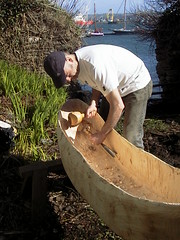Ocean Environment A (20)
History of oceanography; seafloor topography; plate tectonics; isostasy; igneous, metamorphic and sedimentary rock properties; rock cycle; erosion and weathering; sedimentary processes; longshore drift; attrition; colloids; flocculation; estuary formation and classification; headland and bay formation; dune formation; seabed processes; diagnostic tests to determine rock, mineral and sediment type; sediment size measurement and classification; elemental composition of seawater; methods of determining salinity; conservative and non-conservative behaviour; vertical distributions of conservative and non-conservative chemicals; heavy metals; mixing processes; nutrient chemistry; “wet” analytical chemical methods; “dry” analytical chemical methods; chromatography.
Benthic Biology A (20)
Hierarchical taxonomy; phylogenetics; cladistics; binomial nomenclature; principles of classification; anatomical features; identifying features; internal and external skeletons; growth; repair; immune systems; pollution mediation; locomotion; sensory systems; energy partitioning; spermatogenesis; oogenesis; external and internal fertilisation; larval development; avian and mammalian biology; territoriality; aggression and submission; predator and prey detection; feeding strategies; breeding behaviour; cues in initiating breeding behaviour; care of young; innate behaviour; methods of learning; effect of environment on organism behaviour.
Marine Resource Management (20)
Sub sea bed resources – oil, natural gas
Seabed resources – deep sea minerals, shallow sea minerals, aggregates, chemical materials
Water based resources – fishing and aqua culture, mineral extraction, desalination
Sea surface resources – transportation, leisure, tourism
Marine energy resources – waves, wind and tides
Policy and Law (20)
Principles of regulation; environmental ethics; relevant organisations; regulatory frameworks; legislation and case law; waste management and the duty of care; governance and democracy; toxic torts; concepts of negligence; liabilities and obligations; criminality and the law; earth jurisprudence; dispute resolution; decision making strategies; regulatory impact assessments.
Professional Development (20)
Information retrieval and data collection. Citation and referencing. Presentation methods.
Use of information and computer technologies: MS Word, Excel and PowerPoint
Reflective analysis of personal strengths and weaknesses. Personal Development Planning (PDP) and CV compilation; applying for placements/employment; interview techniques.
Science and Statistics (20)
Photosynthesis; cellular respiration; biological molecules; properties of water; pH; elemental chemical properties; half and full equations; isotopes; rate reactions; redox chemistry; acid-base chemistry; inorganic and organic chemical processes; SI units; introductory sound and light transmission physics in water; gravity; mechanical physics; density; adiabatic processes; setting hypotheses; hypotheses testing; null hypotheses; action planning; Gantt charts; assays; selection and use of appropriate marine scientific equipment; repetition of procedures; accuracy and precision; error calculation; type I and II errors; parametric and non-parametric statistical methods for pair-wise and multiple comparisons; regression and correlation.
Marine Practical Skills A (20)
Work Based Learning (20)
Selection of work-based learning experience; CV writing; reflective practice techniques; acquisition of practical skills; health and safety issues; presentation skills.
Second Year:
Ocean Environment B (20)
Currents; the North Atlantic gyre; Gulf Stream; Ekman transport; geostrophic flow; thermocline; halocline; pycnocline; capillary waves; gravity waves; restoring forces and the calculation of wave period, celerity and wavelength; the sun’s influence on the warming of the earth; thermohaline circulation; the development of cloud; the generation of the upper atmosphere and surface winds; the development of the mid-latitude cyclone; understanding and producing a synoptic chart; climate classification; ocean and atmosphere interaction; El Nino and La Nina; North Atlantic Oscillation; global climate change; wave guides; gaseous composition; surface flow and Langmuir flow; vorticity - ocean eddies, atmosphere wave depressions; upwelling and downwelling; dynamic and equilibrium tidal theories; internal waves and celerity of internal waves; Rossby waves and Kelvin waves.
Benthic Biology B (20)
Coastal benthic habitats; continental shelf benthic habitats; bathyal, abyssal and hadal benthic habitats; geographical distributions; ecological processes within marine benthic habitats; natural and artificial stresses; disturbance hypotheses; seasonal cycles in marine benthic habitats; historical and ecological evolutionary theories; survey techniques and mapping; equipment used in benthic surveys; fieldtrip to a coastal location; use of GIS and Surfer; SeaWiFS; use of bioassays and biological indices; scope for growth; factors affecting growth and production; quantitative methods of determining biomass and production
Marine Spatial Planning (20)
Law of the Sea, OSPAR, role of the EU, role of DEFRA, role of the MCA/EA/Local Authorities, Marine Protected Areas, Special Areas of Conservation, anthropogenic development, effects of climate change, role of NGO’s, fisheries management, legal remedies, alternative disputes resolution, acronyms
Environmental Management (20)
The nature of sustainability, environmental protection legislation, environmental liabilities, management policies and systems, industry standard codes of practice, environmental auditing, environmental impact assessments, waste management, energy conservation, employee engagement
Managing Business Activites (20)
Accounting techniques, credit management, purchasing strategies, negotiation, estimates and quotations, slippage control, team motivation, communication, delegation, employment rights, grant applications, risk management, insurance, linguistic barriers, press management, transportation logistics, contract law, GANTT charts, Network Analysis and Microsoft Project software
Project (20)
Planning a project in conjunction with academic staff, negotiating, preparing and submitting a synopsis.
Use of a detailed project logbook of project execution, contacts, decisions, references, time management, discipline, preparing a time line diagram or Gantt chart.
First Oral; presentation of project plan, pace and timing, progress to date.
Carryout laboratory/workshop/library activity including research.
Present progress report supported by log book and time line diagram every 3 to 4 weeks to projects coordinator/supervisor.
Final oral; visual project presentation, Clarity, use of visual aids, models, test results, conclusions.
Preparation and submission of final project report Clarity, layout, use of language.
Coursework Ideas
Env Law: Group work and seminar with presentations on implications and workings of CROW: context - wildlife law
WBL: You wish to work as a volunteer on a worthwhile project in South America. How do you go about this? see http://down2earthdown2us.org/pages/contact.html
